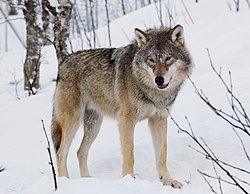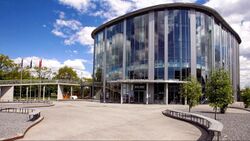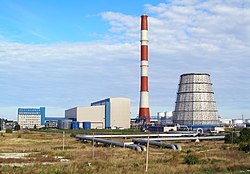Ostrothia: Difference between revisions
Slovertia12 (talk | contribs) No edit summary |
Slovertia12 (talk | contribs) |
||
| Line 133: | Line 133: | ||
Ostrothia is a developed country, with a high-income advanced economy. Ostrothia is a democratic unitary parliamentary republic divided into sixteen counties. It has a population of 2.8 million. Ostrothia has consistently ranked highly in international rankings for quality of life, education, digitalization of public services and the prevalence of technology companies. | Ostrothia is a developed country, with a high-income advanced economy. Ostrothia is a democratic unitary parliamentary republic divided into sixteen counties. It has a population of 2.8 million. Ostrothia has consistently ranked highly in international rankings for quality of life, education, digitalization of public services and the prevalence of technology companies. | ||
==History== | ==History== | ||
===Prehistory=== | |||
The earliest traces of human settlement in Ostrothia date back to 10,000 BC. The earliest settlements in Ostrothia include the mesolithic Rälti settlement is located by the Rõlva River. Bone and stone artifacts similar to those found at the Rälti settlement have been found all over Ostrothia. Among minerals, flint and quartz were used the most for making cutting tools. | |||
==Geography== | ==Geography== | ||
Revision as of 11:42, 28 May 2021
This article is incomplete because it is pending further input from participants, or it is a work-in-progress by one author. Please comment on this article's talk page to share your input, comments and questions. Note: To contribute to this article, you may need to seek help from the author(s) of this page. |
Republic of Ostrothia Ostrii Vabariik | |
|---|---|
| Motto: Isamaa eest! For Fatherland! | |
| Capital and | Rõlva |
| Official languages | Ostrothian |
| Demonym(s) | Ostrothian |
| Government | Unitary Parliamentary Republic |
• President | Leana Aarma |
• Prime Minister | Artur Jõeäär |
| Legislature | Rahvakogu |
| Area | |
• | 63,400 km2 (24,500 sq mi) |
| Population | |
• Estimate | 2,890,000 |
| GDP (PPP) | 2021 estimate |
• Per capita | $52,543 |
| GDP (nominal) | estimate |
• Total | $58.97 billion |
• Per capita | $25,752 |
| Gini (2021) | 38.4 medium |
| Currency | Ostrothian Mark (OMK) |
| Date format | yyyy-mm-dd |
| Driving side | right |
| Calling code | +530 |
Ostrothia (Ostrothian: Ostrii), officially the Republic of Ostrothia (Ostrothian: Ostrii Vabariik), is a country in Astyria. Ostrothia covers a total area of 63,400 km2 (24,478 sq mi), and is influenced by a humid continental climate. Rõlva, the capital of Ostrothia, and Laadu are the largest cities and urban areas in the country. Other notable cities include Haku, Novessaare, Jõhku and Soulu. The official language of the country, Ostrothian, is a Finnic language.
Ostrothia is a developed country, with a high-income advanced economy. Ostrothia is a democratic unitary parliamentary republic divided into sixteen counties. It has a population of 2.8 million. Ostrothia has consistently ranked highly in international rankings for quality of life, education, digitalization of public services and the prevalence of technology companies.
History
Prehistory
The earliest traces of human settlement in Ostrothia date back to 10,000 BC. The earliest settlements in Ostrothia include the mesolithic Rälti settlement is located by the Rõlva River. Bone and stone artifacts similar to those found at the Rälti settlement have been found all over Ostrothia. Among minerals, flint and quartz were used the most for making cutting tools.
Geography
Ostrothia is a relatively low lying nation with an abundance of lakes, bogs and forests. Average elevation reaches only 50 metres (164 ft) and the country's highest point is Lõuna mägi in the south at 350 metres. There is 5,600 kilometres of coastline marked by numerous bays, straits, and inlets.
Ostrothia has a number of islands dotted around its coast. Ostrothia has over 2,000 lakes. Most are very small, with the largest, Lake Võit, being 2,150 km2. There are many rivers in the country. The longest of them are the Rõva, Rõlva which the capital of Ostrothia takes its name and Pätsemaa. Ostrothia has numerous fens and bogs. Forest land covers 48% of Ostrothia. The most common tree species are pine, spruce and birch.
Climate
Ostrothia is a northerly nation. The climate is more continental in the eastern part of the country and more maritime in the western part. Ostrothia has four seasons of near-equal length. Average temperatures range from 17.8 °C (64.0 °F) inland in July, the warmest month, and from −1.4 °C (29.5 °F) inland in February, the coldest month. The average annual temperature in Ostrothia is 6.4 °C (43.5 °F). Annual average precipitation is 662 mm. The average for the year is 1829.6 hours of sunshine. The duration of sunshine is highest in coastal areas and lowest inland in northern Ostrothia.
Enviroment
Ostrothia agreed to cut carbon emissions by at least 20% of 1990 levels by the year 2020 and by at least 40% by the year 2030. Also, by 2020 at least 20% (27% by 2030) of the country's total energy consumption should be from the renewable energy sources. In 2016, Ostrothia introduced especially effective container deposit legislation, which resulted in collecting 92% of all packagings in 2017.
Ostrothia does not have high mountains and its landscape is dominated by blooming meadows, dense forests and fertile fields of cereals. However it stands out by the abundance of hillforts. Ostrothia is a particularly watered region with more than 2,000 lakes, mostly in the northwest. The country is also drained by numerous rivers.
Forest has long been one of the most important natural resources in Ostrothia. Forests occupy half of the country's territory and timber-related industrial production accounts for almost 11% industrial production in the country. Ostrothia has five national parks, 18 municipal parks, 500 nature reserves, 1,668 state-protected natural heritage objects.
Biodiversity
Ostrothian ecosystems include natural and semi-natural (forests, bogs, wetlands and meadows), and anthropogenic (agrarian and urban) ecosystems. Among natural ecosystems, forests are particularly important to Ostrithia, covering 48% of the country's territory. Wetlands (raised bogs, fens) cover 7% of the country, with 52% of wetlands having been lost due to drainage and peat extraction between 1952 and 1983. Changes in wetland plant communities resulted in the replacement of moss and grass communities by trees and shrubs, and fens not directly affected by land reclamation have become drier as a result of a drop in the water table. There are 23,000 rivers with a total length of 59,000 km in Ostrothia.
Agricultural land comprises 32% of Ostrothia's territory (roughly 70% of that is arable land and 30% meadows and pastures), approximately 400,000 ha of agricultural land is not farmed, and acts as an ecological niche for weeds and invasive plant species. Habitat deterioration is occurring in regions with very productive and expensive lands as crop areas are expanded.
The wildlife populations have rebounded as the hunting became more restricted and urbanization allowed replanting forests (forests already tripled in size since their lows). Currently, Ostrothia has approximately 250,000 larger wild animals or 5 per each square kilometer. The most prolific large wild animal in every part of Ostrothia is the deer, with 200,000 of them. They are followed by boars (48,000) and the largest one: moose (~12,000). Among the Ostrothian predators, wolves are the most common (~29,000). The large animals mentioned above exclude the rabbit, ~280,000 of which may live in the Ostrothian forests.
Politics
Ostrothia is a unitary parliamentary republic. The unicameral parliament Rahvakogu serves as the legislative and the government as the executive.
Ostrothian parliament is elected by citizens over 18 years of age for a four-year term by proportional representation, and has 200 members. Rahvakogu's responsibilities include approval and preservation of the national government, passing legal acts, passing the state budget, and conducting parliamentary supervision. On proposal of the president appoints the Chief Justice of the Supreme Court, the chairman of the board of the Bank of Ostrothia, the Auditor General, the Legal Chancellor, and the Commander-in-Chief of the Defence Forces.
The Government of Ostrothia is formed by the Prime Minister of Ostrothia at recommendation of the President, and approved by the Rahvakogu. The government, headed by the Prime Minister, represent the political leadership of the country and carry out domestic and foreign policy. Ministers head ministries and represent its interests in the government. Sometimes ministers with no associated ministry are appointed, known as ministers without portfolio. Ostrothia has been ruled by coalition governments because no party has been able to obtain an absolute majority in the parliament.
The head of the state is the President who has primarily representative and ceremonial role. The president is elected by the Rahvakogu. The President proclaims the laws passed in the Rahvakogu , and has right to refuse proclamation and return law in question for a new debate and decision. If Rahvakogu passes the law unamended, then the President has right to propose to the Supreme Court to declare the law unconstitutional. The President also represents the country in international relations.
Ostrothia has pursued the development of the e-government, with 99 percent of the public services being available on the web 24 hours a day. In 2005 Ostrothia became the first country in the world to introduce nationwide binding Internet voting in local elections of 2005. In 2020 parliamentary elections 54% of the total votes were cast over the internet.
Foreign Relations
law enforcement
Crime in Ostrothia has been declining rapidly. Law enforcement in Ostrothia is primarily the responsibility of local Ostrii Politsei (Ostrothian Police) commissariats. Capital punishment in Ostrothia was suspended in 1986 and fully eliminated in 1989.
Military
The Ostrothian Armed Forces consist of land forces, navy, and air force. The current national military service is compulsory for healthy men between ages of 18 and 28, with conscripts serving 8 or 11-month tours of duty, depending on their education and position provided by the Armed Forces. The peacetime size of the Ostrothian Defence Forces is about 8,000 persons, with half of those being conscripts. The planned wartime size of the Defence Forces is 72,000 personnel.
Administrative Divisions
Ostrothia has sixteen counties which are subdivided into 7 municipalities each. Local affairs are managed autonomously by local governments. Since administrative reform in 2018, there are in total 112 local governments. All municipalities have equal legal status and form part of a county, which is a state administrative unit. Representative body of local authorities is municipal council, elected at general direct elections for a four-year term. The council appoints local government, headed by a mayor.
Economy
Ostrothia has open and mixed economy that is classified as a high-income economy. According to data from 2019, the three largest sectors in the Ostrothian economy are – services (60% of GDP), industry (30%) and agriculture (3%).
Agricultural products and food made 20%, chemical products and plastics – 15%, machinery and appliances – 15%, mineral products – 12.3%, wood and furniture – 12.5% of exports. The Ostrothian GDP experienced very high real growth rates for decade up to 2009, peaking at 12% in 2005. As a result, the country was often termed as an Ostrothian Tiger. However, in 2009 due to a global financial crisis marked experienced a drastic decline – GDP contracted by 14.9% and unemployment rate reached 16% in 2009. After the decline of 2009, Ostrothian annual economic growth has been much slower compared to pre-2009 years. According to data, financial conditions are conducive to growth and financial soundness indicators remain strong.
As of 2019, Ostrothian mean wealth per adult is $52,000. Ostrothia has a flat tax rate rather than a progressive scheme. The personal income tax (15%) and corporate tax (15%) rates in Ostrothia are among the lowest in Lorecia. The country has the lowest implicit rate of tax on capital (10%). Corporate tax rate in Ostrothia is 15% and 5% for small businesses. Information technology production is growing in the country, reaching 10.9 billion Marks in 2017.
Energy
Ostrothia is dependent on other countries for energy. In recent years, many local and foreign companies have been investing in renewable energy sources. Wind power has been increasing steadily in Ostrothia.
Currently, there are plans to renovate some older units of the Laadu Power Plants, establish new power stations, and provide higher efficiency in oil shale-based energy production. The country's main energy supplier is Ostrii Energia.
Transport
Ostrothian Railways' main network consists of 1,920 km of 1,520 mm gauge railway of which 188 km are electrified. Ostrothian railway network also has 200 km of standard gauge lines. Half of all inland freight transported in Ostrothia is carried by rail. Ostrothia has an extensive network of motorways.
The Port of is the only commercial cargo port in Ostrothia. In 2011 56 million tons of cargo were handled. there are ongoing expansion plans to midernise the port.
Rõlva International Airport is the largest airport in Ostrothia. It served 4.2 million passengers in 2016. Other international airports include Laadu International Airport, Haku International Airport and , Novessaare International Airport.
Demographics
Ethnic Ostrothians make up about seventy percent of the country's population. In 2015, the population of Ostrothia stands at 2.8 million, 88% of whom speak Ostrothian, which is the official language of the country. Several sizeable minorities exist, such as Valkeans (20%) and other peoples of the Lorecian continent (7%). Valkeans in Ostrothia are the largest minority, concentrated in the northeast.
Language
The official language is Ostrothian, but in some areas there is a significant presence of minority languages, such as Valkean and other Lorecian languages. The state laws guarantee education in minority languages and there are numerous publicly funded schools in the areas populated by minorities, with Valkean as the language of instruction being the most widely available.
According to the Ostrothian population census of 2017, about 88% of the country's population speak Ostrothian as their native language, 7% are native speakers of Valkean and 5% of other Lorecian languages. About 50% of Ostrothian residents speak Valkean as a foreign language, 20% – Dutch, 10% – German, 4% - French. Most Ostrothian schools teach Valkean as the first foreign language, but students may also study Dutch, or, in some schools, French or Scannonian.
Religion
Religions in Ostrothia (2017)
In recent years Ostrothia has become increasingly secular, with an increasing number who identify as religiously "undeclared". The largest majority groups are the various Christian denominations, principally Lutheran and Catholics, with very small numbers of adherents in non-Christian faiths, namely Judaism and Islam. Other polls suggest the country is broadly split between Christians and the non-religious / religiously undeclared. Ostrothia was Christianised by the Catholic Knights in the 13th century. The Protestant Reformation led to the establishment of the Ostrothian church in 1682. Many Ostrothians profess not to be particularly religious.
Today, Ostrothia's constitution guarantees freedom of religion, separation of church and state, and individual rights to privacy of belief and religion. The historic Lutheran denomination has a large presence.
Education
Education in Ostrothia is divided into general, vocational, and hobby. The education system is based on four levels: pre-school, basic, secondary, and higher education. A wide network of schools and supporting educational institutions have been established. The Ostrothian education system consists of state, municipal, public, and private institutions. There are currently 920 schools in Ostrothia.
Academic higher education in Ostrothia is divided into three levels: bachelor's, master's, and doctoral studies. In some specialties (basic medical studies, veterinary, pharmacy, dentistry, architect-engineer, and a classroom teacher programme) the bachelor's and master's levels are integrated into one unit. Ostrothian public universities have significantly more autonomy than applied higher education institutions. In addition to organising the academic life of the university, universities can create new curricula, establish admission terms and conditions, approve the budget, approve the development plan, elect the rector, and make restricted decisions in matters concerning assets. Ostrothia has a moderate number of public and private universities. The largest public universities are the University of , Laadu University, Technological University, Ostrothian University of Sciences, Ostrothian Academy of Arts.






